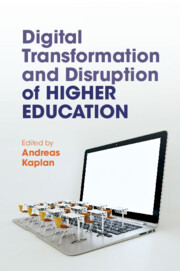Book contents
- Digital Transformation and Disruption of Higher Education
- Digital Transformation and Disruption of Higher Education
- Copyright page
- Contents
- Figures
- Tables
- Contributors
- Preface
- Chapter 1 Nothing Is Constant Except Change
- Part I (R)evolution of the Higher Education Sector
- Part II Changes in Teaching Formats
- Part III Changes in Teaching Content
- Part IV Networking and Social Activities
- Part V Certification and Diplomas
- Part VI Careers and Professionalisation
- Chapter 23 About University Career Services’ Interaction with EdTech
- Chapter 24 About Training Educators to Become Drivers for Change
- Chapter 25 About Instructors’ Readiness to Teach Online
- Chapter 26 About Precarious Faculty and Their Digital Disruption
- Part VII Futuristic and Ultramodern Higher Education
- Part VIII Higher Education in Motion
- Editor’s Biography
- Index
- References
Chapter 25 - About Instructors’ Readiness to Teach Online
from Part VI - Careers and Professionalisation
Published online by Cambridge University Press: 09 June 2022
- Digital Transformation and Disruption of Higher Education
- Digital Transformation and Disruption of Higher Education
- Copyright page
- Contents
- Figures
- Tables
- Contributors
- Preface
- Chapter 1 Nothing Is Constant Except Change
- Part I (R)evolution of the Higher Education Sector
- Part II Changes in Teaching Formats
- Part III Changes in Teaching Content
- Part IV Networking and Social Activities
- Part V Certification and Diplomas
- Part VI Careers and Professionalisation
- Chapter 23 About University Career Services’ Interaction with EdTech
- Chapter 24 About Training Educators to Become Drivers for Change
- Chapter 25 About Instructors’ Readiness to Teach Online
- Chapter 26 About Precarious Faculty and Their Digital Disruption
- Part VII Futuristic and Ultramodern Higher Education
- Part VIII Higher Education in Motion
- Editor’s Biography
- Index
- References
Summary
Faculty readiness in any context is a measure of the preparedness of faculty to teach in that context. This quantitative case study examines the higher education instructors’ perceptions of their readiness to teach online. It highlights how the sudden pandemic triggered transformation of higher education to the virtual modality has disrupted teaching at places like Pakistan where the educators were not ready enough for the transition since it involves more than switching to an online modality as Kaplan propounds (see chapter 1 of this volume). The urgency of the situation made teachers feel overwhelmed without necessary guidance and training. This chapter also offers recommendations on what can be done about the situation. The teacher-readiness questionnaire developed by Martin, Budhrani and Wang (2019) was adapted according to the context of the study. The data collected from 170 instructors were analysed statistically by employing descriptive statistics and MANOVA through SPSS. The findings of the survey have significant implications for instructors, heads of higher education institutions, higher education commission and policy makers in similar countries.
Keywords
Information
- Type
- Chapter
- Information
- Digital Transformation and Disruption of Higher Education , pp. 333 - 344Publisher: Cambridge University PressPrint publication year: 2022
